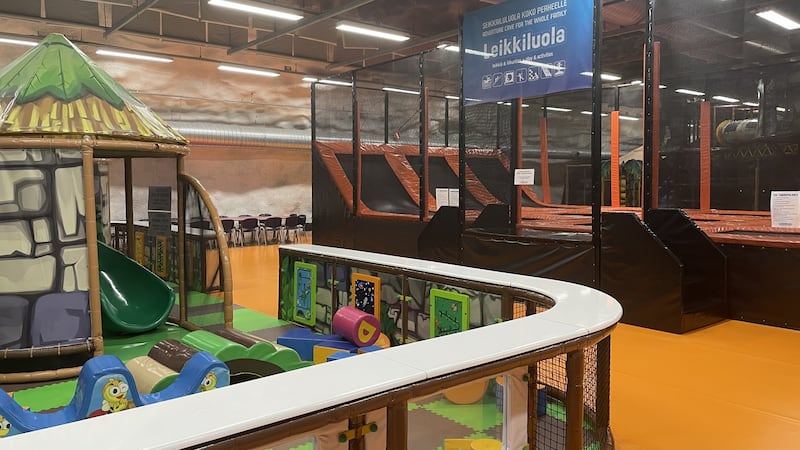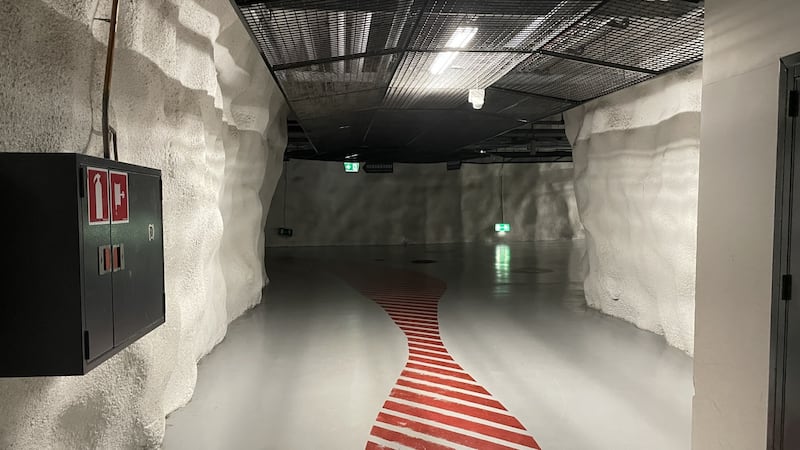The rocky ground beneath Finland's capital, Helsinki, is filled with more holes than the Emmentaler cheese Finns enjoy with their morning rye bread.
Take, for instance, the unremarkable glass hut standing beside a Helsinki market hall which houses an elevator entrance to the Arena sport centre.
After a 20-second ride underground you emerge into a crooked corridor of whitewashed rock walls, 30m below street level. Pass some sets of huge blue blast doors and you emerge in a large bright space with multi-functional sports courts, stalls selling snacks and hockey equipment as well as a colourful area dubbed “Leikkiluola”.
This self-described “adventure cave for the whole family” has slides, climbing frames, a ball pool and more. Look closer at the shafts and pipes and you realise that this space is, in fact, a massive underground bunker.
“This is the place to be when the Russians invade,” joked one middle-aged man visiting on Saturday.
At 1,340km, Finland's border with Russia is half the length of the island of Ireland's entire coastline. In cold war times, fears of the Soviet Union – an invasion, its nuclear capability, a series of erratic leaders in Moscow – saw Finland launch a remarkable underground building project in its cities.
The legacy in the capital is 10 million square metres of underground space which, thanks to remarkable political foresight, has been kept intact and operational even after, in recent decades, neighbouring Sweden mothballed much of its cold war readiness plans.

Helsinki’s underground city – which can be converted quickly to house the civilian population – is mostly used as swimming pools, churches, galleries and sports facilities.
"It's not like they are just waiting there empty for a war that never comes," says Jyri Lavikainen.
Eerie foresight
When he’s not training at the Arena centre, Lavikainen is a specialist on Russia’s foreign and security at Finland’s Institute for International Affairs (FIIA). Last week, as well as breaking some national weight-lifting records, he helped complete a two-year FIIA study into Russian-Nordic relations.
Like Finland’s underground infrastructure, the research project began in a very different time and now has an air of eerie foresight.
Russia's invasion of Ukraine means that, for Finns, all previous bets with Russia – and ideas of neutrality and non-alignment – are null and void.
Two-thirds of Finns want to join Nato – ideally with Sweden – as soon as possible, a massive swing in public opinion that has left politicians racing to catch up.
Upgrading the existing close Finnish-Nato partnership to full membership is not without risks. But the erratic behaviour of the Russian president, Finnish analysts say, makes being outside Nato as risky as being inside.
Reading Russia’s messaging on its Nordic neighbours, Lavikainen flags how Moscow’s rhetoric and strategies are based on “half-truths and outright lies”.
Analysing all Russian foreign ministry messaging on the Nordic-Baltic region in the last years, FIIA researchers note Moscow’s insistence that any security moves it makes in the Baltic region merely mirror what others have done first.

“They try to frame this as reciprocal but it is the Russians who have pushed for regional, conventional superiority in the region,” says Lavikainen.
He points to the massive military modernisation in the Kola Peninsula, in Russia's northwest, regular Russian incursions into neighbours' airspace – the latest reported this week by Sweden – and Russia's "fortress" exclave of Kaliningrad, near Gdansk.
Psychiatric language
Another Russian tactic Finnish researchers see at play in the Ukraine crisis is gaslighting critics, denouncing them using the language of mental illness.
“Russians respond to any critical discussion of their actions using terms like hysteria, paranoia, mania,” says Lavikainen.
Another pattern – using threats to demand respect – was visible last week when Russian president Vladimir Putin warned of new, unstoppable nuclear weapons that he isn't afraid to use. While some around Europe reacted with concern, Finnish analysts and officials rolled their eyes.
Making nuclear threats, according to retired Finnish general Pekka Toveri, “is a sign of weakness, not strength”.
“It is just rhetoric to scare people who don’t understand these things,” he said. And what of speculation that Nato members will locate some of their nuclear capability on Finnish soil after it joins the alliance – offering Russia a pretext for a counter-move?
“Why bring them to the border, inside the range of all Russian systems? They won’t do that, it would be extremely stupid to bring them so close,” says Toveri.
High military spending on equipment and Nato-compatible systems mean Finland will be a model alliance partner, he thinks, but concerns remain of what happens in the “grey zone”: after Helsinki applies to join and before all 30 alliance members have agreed.
Toveri’s brisk assessment reduces the risk here to manageable levels: Russia’s invasion has destroyed any political or economic leverage with Finland.
With its army tied up in Ukraine, he suggests any conventional military action in the Baltic Sea is unlikely, particularly as it would endanger Russian energy pipelines – today the country’s main source of income.
“Putin wants to threaten Finland one way or another though a Russian military action would be lost in a humiliating defeat,” he says. As with its underground network of bunkers, Toveri insists that Finland has prepared as best it can for a likely wave of hybrid and cyberattacks. “You have to remember,” he says, “that we are talking now about an unhinged dictator.”












